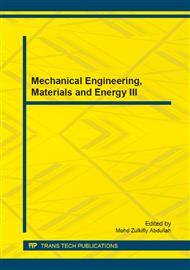p.96
p.100
p.105
p.110
p.115
p.119
p.124
p.130
p.134
Effects of the Preparation Parameters on the Properties of Graphite/Carbon Fiber/Copper/Phenolic Resin Composites
Abstract:
The polymer composites consist of phenolic resin, natural graphite, carbon fiber and copper powder, are fabricated by hot compression moulding or compression moulding followed by post-curing. The density, electrical conductivity and flexural strength of composites are analyzed to determine the influences of post-curing temperature and preparing method on the physical, electrical and mechanical properties of composites. It is found that the density, electrical conductivity and flexural strength of composites increase with increasing post-curing temperature for composites prepared by compression moulding followed by post-curing. The flexural strength is more strongly dependent on post-curing temperature. At 170 °C, the density, electrical conductivity and flexural strength of composites were 1.85 g/cm3, 2.94 × 103 S/m and 40 MPa respectively. The cross-linking skeleton structure well established in the composites could be the main reason for the largely increasing of flexural strength as post-curing temperature increases. The results also show that the properties of composites prepared by hot compression moulding are higher than those of composites prepared by compression moulding followed by post-curing.
Info:
Periodical:
Pages:
115-118
Citation:
Online since:
December 2013
Keywords:
Price:
Сopyright:
© 2014 Trans Tech Publications Ltd. All Rights Reserved
Share:
Citation:


